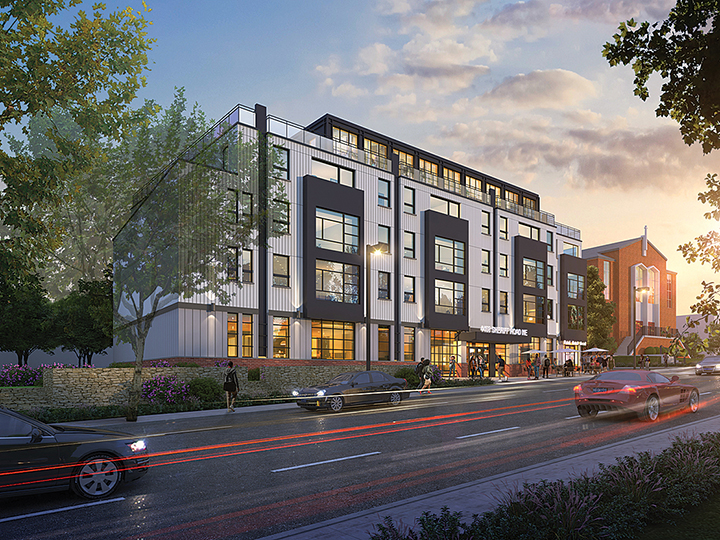
By Ravi Waldon, AIA, LEED AP
Ministries are getting really creative at both extending their reach into the community and also improving their financial sustainability as they evaluate and deal with ministry trends accelerating post-pandemic.
With respect to the physical facilities and property they steward, they ask: Is there a different approach to church property that will allow each church to minister to its community more effectively while also maintaining a more sustainable financial model?
Recently, a recurring answer to that question is to develop church-owned property with mixed-use facilities.
Instead of constructing Sunday-only worship centers, ministries are learning to be vibrant partners in community life, providing much-needed community centers, affordable housing, senior living, retail, or other creative venues to the neighborhoods their congregations call home. Understandably, most churches have either not fully considered or are genuinely overwhelmed at the thought of strategically developing their property with mixed-use. While this can be daunting, this mindset for the church is far from new and applies to rural, small town, suburban and urban churches.
Over the past few years, we have been genuinely blessed with the opportunity to work with some of these ministries.

Owned and operated by a local church, Ragamuffins Coffee House in Laurel, Md., is open all week and regularly makes its space available to community yoga classes, game nights, coffee-pouring and tasting events, and hosting musicians for live music.
One church in rural Tennessee saw its community’s lack of public amenities and envisioned using not only its current property but also sought to acquire and build out the large, empty parcel across the road to provide for that need. Recognizing the large percentage of single-parent households, its facility design included a coffee shop and adjacent children’s indoor playground. Its masterplan included affordable housing, a worship space that doubled as a large event venue, senior living, a Christian K-12 school, a youth sports venue, a daycare, indoor playground, a weekday café, and an outdoor park. Some of these spaces would be the only public spaces of their kind within reasonable driving distance for their congregation’s community.

Another large church in suburban Richmond, Va., saw developing a new campus for its multi-site vision as an opportunity to not only create continued revenue for its ministry, but also create a hub for neighborhood activity. Leaders intentionally included a drive-in event venue (too bad it didn’t get built before the pandemic), community center, and childcare center in the plans, and subdivided their property to create leasable pad sites for retail.
At a much smaller scale, leaders at a church in the small town of Laurel, Md., felt called to be more deeply engaged with their neighbors and realized that their location limited them from doing so. This led them to buy and renovate property on their local Main Street.
On Sundays, the facility is used as a church for about 50 people. The rest of the week, Ragamuffins Coffee House serves some of the best coffee in town, and regularly makes its space available to community yoga classes, game nights, coffee-pouring and tasting events, and hosting local musicians for live music. This setup has been profoundly impactful for the church, providing a dedicated space where they can interact with each other and share the love of Christ with their community mid-week.

In Washington, DC, Enterprise Community Partners nonprofit has built a coalition of “cohort” churches seeking to deliver 1,200 affordable housing units in the city by 2025.
Churches in Washington, DC, have come together to address the lack of affordable housing in the city. For example, the Enterprise Community Partners nonprofit has built a coalition of “cohort” churches seeking to deliver 1,200 affordable housing units in the city by 2025 while working closely with City leadership. Each of these churches has a church building and is looking to fill the rest of its zoning envelope with affordable housing, affordable senior rentals or, in some instances, for-sale units. Churches in the cohort receive a small grant to have a visionary package developed to help understand what could be built. Then, developers partner with the churches and, in so doing, bring the capital required for development. The money a church earns from these developments can then get plugged back into ministry, increasing the potential ministry impact for years to come.
A mixed-use development model varies in the uses but should always be based on the best ways to minister to the community. At the same time, it creates an entirely new avenue for financial stability. These developments do not always require a large capital investment by a congregation — just a willingness to think differently. Shared-ownership strategies with like-minded developers or long-term land leases continue to generate revenue for a congregation to use in its ministries.
It is always encouraging to see ministries with a vision to reach the community faithfully grow their ministries. For them, mixed-use development gave them the freedom and capability to do just that. Whether large or small, they were willing to mix it up to better share the love of Christ any way they can.
Ravi Waldon, AIA, LEED AP, is a Principal and Faith-Based Practice leader at Michael Graves Architecture. The firm serves ministries nationwide and shares in the heart of ministry through its design of churches, housing, senior living, schools, healthcare, and historic preservation.


